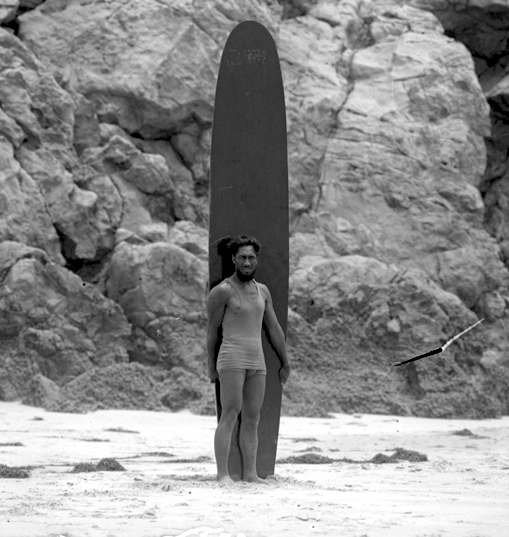Like anyone getting hooked on a new sport, it’s often intriguing to dig into where the sport originally began, the history of surfing is fascinating.
The origins of surfing are somewhat hazy. We can trace it back to ancient 12th-century caving paintings in Polynesia that depicted people riding waves.
It’s said that the first surfers were fishermen who found that it was quicker and much more efficient to cruise on the waves all the way to shore. Eventually, this practice evolved into something for enjoyment as well as a useful technique for fishing. The Polynesians took surfing to Hawaii where it quickly became engrained in the islands’s culture and religion.
There are early records by discoverer Captain James Cook in the 1700s, where he describes people in Tahiti having fun catching waves on a canoe.
“I saw a man paddling in a small canoe so quickly and looking about him with such eagerness of each side. He then sat motionless and was carried along at the same swift rate as the wave, till it landed him upon the beach. Then he started out, emptied his canoe, and went in search of another swell. I could not help concluding that this man felt the most supreme pleasure while he was driven on so fast and so smoothly by the sea.”.
After Captain James Cook’s untimely death in 1779, his lieutenant, James King wrote a description of surfing at Kealakekua Bay on Hawaii’s big island: “It sends them in with a most astonishing velocity…the great art is to guide the plank…on top of the swell.”
The debate: Where did surfing originate?
There’s little doubt that the birthplace of surf culture was Hawaii but there’s still debate around where surfing actually originated. With more evidence being found including the discovery that a civilisation was catching waves on the north coast of Peru for 2000 years.
Way before the Incas in northern Peru the Moche and Chimu cultures relied on fishing to survive. Like the Polynesian people, they used the waves to propel them back to shore on their boats. In the ancient Chimu pottery art there are depictions of fishermen riding waves that goes back at least 2000 years. The pottery also suggest that they weren’t just surfing as a fast way to bring their catch back to shore but also just for fun. There’s also more discussion around whether you can class what the Peruvians were doing as surfing. Fishermen used straw canoes called “Caballito de Tottora” to ride waves but were stood tall, upright with a paddle to manoeuvre.
The Origin of Surf Culture in Hawaii
The impact of European culture on surfing in Hawaii was pretty devastating. The islands were vulnerable to European diseases (syphilis struck the population) and the Hawaiian people found themselves with little free time for surfing and their cultural traditions due to the painstaking work in the sugar plantations. Surfing in Hawaii was in major decline by 1890.
In the late 19th Century American tourists arrived on Waikiki Beach mesmerised by Hawaiian surfers riding the waves, some had lessons and demonstrations from the locals. Around the same period, three Hawaiian princes took their surfing skills to California to the surprise of the bemused onlooking locals.
Mark Twain had already attempted surfing in Hawaii back in 1866 and Jack London wrote about his experience in an essay, “A Royal Sport” which was published in October 1907. Word of surfing began to spread.
Surf Legend Duke Kahanamoku
If Hawaii had kick-started it, California and Australia were leading the way in surfing in 1915. The early twentieth century had seen the revival of surfing in Hawaii with the help of legendary Duke Kahanamoku (nicknamed “The Duke”), an
Kahanamoku won five Olympic medals as a swimmer, appeared in movies, was involved in politics and business. With his talents as a superb swimmer, he toured the world teaching his trademark “Kahanamoku Kick” technique. On 10th January 1915, The Duke starred in a summer exhibition at Freshwater Beach in Sydney, Australia in front of a crowd of 400. At the time the Sydney Morning Herald wrote:
“[Kahanamoku] came out with his surfboard, plunged into the water, and continued to swim out until those watching from the beach wondered when he would stop. After covering nearly half a mile, Kahanamoku turned and prepared for a roller, which came along a moment after; he caught it, and as the wave carried him shorewards, he performed all kinds of acrobatic feats on the board, and finally dived into the water as the roller broke.”
You can still find Duke Kahanamoku’s board on display in the Freshwater Surf Life Saving Club, Sydney, Australia.
“Before I left that fabulous land, the Australians had already turned to making their own boards and practicing what I had shown them in the surf.”
– Duke Kahanamoku
20th Century Surfing Culture
In the US and Australia during the 20th century came development and innovation in surf culture with surfboards becoming much shorter, lighter, more manoeuvrable, more hydrodynamic allowing new styles to emerge. Surf breaks all over the world were discovered as newcomers started to pick up the sport in search of a wave fuelled adrenaline kick.
From a niche unconventional sport to a national sport, by the 1960s surf culture had hit the mainstream with movies, surf music, and even the Beach Boys getting worldwide attention.
In 1969, the first world surfing competition took place at the Smirnoff World Pro-Am, shortboards were built and surfing becomes professional.
During the 1970’s surfing companies like Rip Curl, Billabong and Quicksilver sprouted up and the three fin system was invented by Simon Anderson which led to the development of the shortboard as we know it today. The ’90s saw a revolution in surfing led by Kelly Slater who was a world champion on twelve occasions.
In 2016 the decision was made by The International Olympic Committee (IOC) to include surfing in the 2020 Tokyo Olympic Games.
